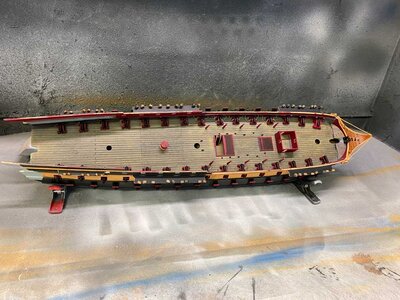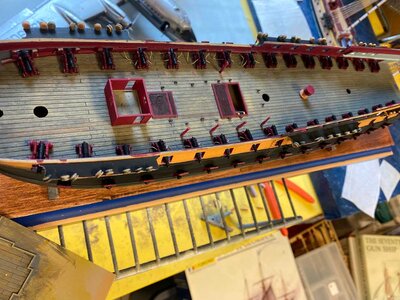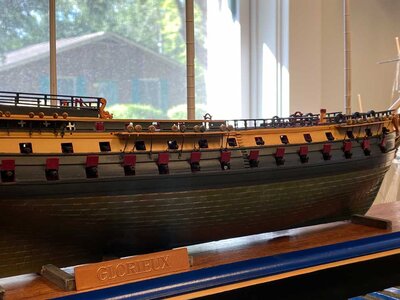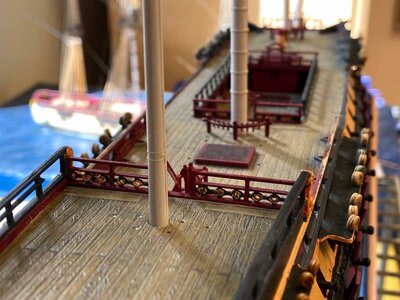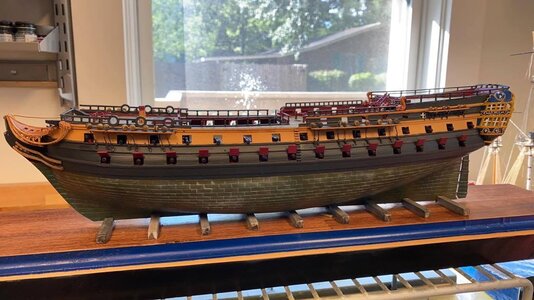At the same time I started La Flore, I also started on Glorieux. The initial build process didn't last long. I just wasn't feeling it at the time, so up she went on a shelf of doom where she remained for two years. While I was at sea a year ago, I came across a painting of the French 74 gun ship Le Lys (ex Commerce de Marseille). The painting indicates this was her appearance in the early to mid 1780s and I found the paint scheme striking and different. Paintings of the battles in which Glorieux was involved towards the end of her career show ships with black wales and yellow ochre or buff topsides, but also some where the blacking extends above the wale into the line of gun deck gun ports. So I thought, it may not be historically accurate, but I really like it, so let's go!
Here she is as she went to the shelf of doom - terrible wood grain intact, typical yellow topsides with blackened wales:
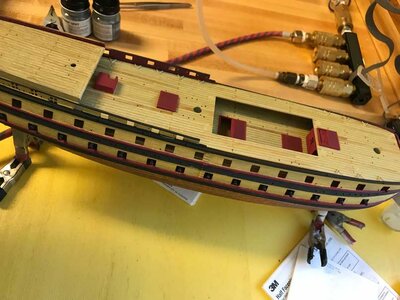
And here is that painting of Le Lys:
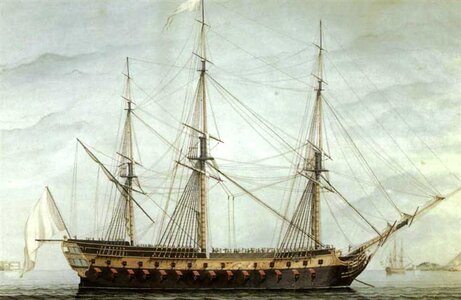
So, with my newfound inspriration, I took Glorieux completely apart, sanded off the wood grain (keeping the hull smooth - no planking seams), repainted the hull, dulled down the deck, and also used strip styrene around the interior of the gunports. In the waist, I planked the interior fully with the styrene strips as it can just be seen under the gangways. I did not have the foresight to take pictures of the "planking," unfortunately.
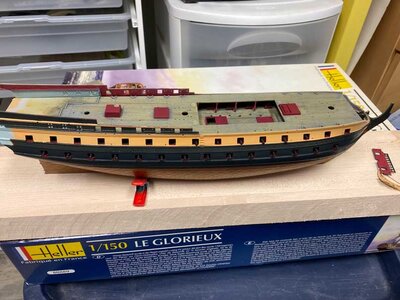
With her fresh paint. I like it much better. The yellow color is vallejo flat flesh, which is a very near match to HMS Victory's new paint color. The "black" is vallejo gray black, which is also a close match to the dark gray of Victory.
I gave her a gloss coat at this stage and I used some raw umber oils to wash over her. The effect gave the hull an aged patina not unlike an old model in a museum, so that settled on me on the "look" I'm going for over all. The copper sheathing that is molded on the hull I didn't remove. Boudriot's books indicate it's highly unlikely she was coppered, however, there is some anecdotal evidence to indicate she was, so I left it. I did turn it green, however, as you see here, in the next photo:
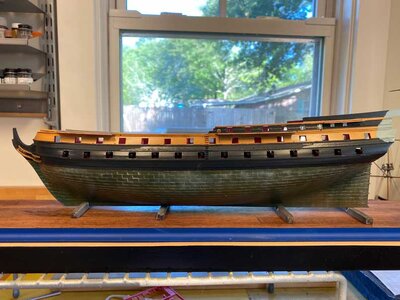
Now I think we are getting somewhere. The oil wash has "aged" the yellow color. The matte areas under the yellow are touch-ups of the black paint. I kept the fresh copper paint underneath, but built up several shades of green, from bright to black-green, using my airbrush. I then dry brushed on gray-green, which appears almost white in the photo, to give it that extra aged patina, like she's been sitting still for a long time.
Interestingly enough, ships with coppered bottoms often were brighter around the waterline after being underway, especially at the bow, as the action of the saltwater scours the copper bright. I have seen this in person on one of the vessel I've worked on, which is fully coppered.
The base under her in the last photo is the raw butcher block from the third photo after having been put to my router and painted using the hull colors and the blue I will use on her stern and quarter galleries.
I think that's a good start for now. Much like La Flore, Glorieux sits on my bench at home, waiting patiently for me to get back.
G
Here she is as she went to the shelf of doom - terrible wood grain intact, typical yellow topsides with blackened wales:

And here is that painting of Le Lys:

So, with my newfound inspriration, I took Glorieux completely apart, sanded off the wood grain (keeping the hull smooth - no planking seams), repainted the hull, dulled down the deck, and also used strip styrene around the interior of the gunports. In the waist, I planked the interior fully with the styrene strips as it can just be seen under the gangways. I did not have the foresight to take pictures of the "planking," unfortunately.

With her fresh paint. I like it much better. The yellow color is vallejo flat flesh, which is a very near match to HMS Victory's new paint color. The "black" is vallejo gray black, which is also a close match to the dark gray of Victory.
I gave her a gloss coat at this stage and I used some raw umber oils to wash over her. The effect gave the hull an aged patina not unlike an old model in a museum, so that settled on me on the "look" I'm going for over all. The copper sheathing that is molded on the hull I didn't remove. Boudriot's books indicate it's highly unlikely she was coppered, however, there is some anecdotal evidence to indicate she was, so I left it. I did turn it green, however, as you see here, in the next photo:

Now I think we are getting somewhere. The oil wash has "aged" the yellow color. The matte areas under the yellow are touch-ups of the black paint. I kept the fresh copper paint underneath, but built up several shades of green, from bright to black-green, using my airbrush. I then dry brushed on gray-green, which appears almost white in the photo, to give it that extra aged patina, like she's been sitting still for a long time.
Interestingly enough, ships with coppered bottoms often were brighter around the waterline after being underway, especially at the bow, as the action of the saltwater scours the copper bright. I have seen this in person on one of the vessel I've worked on, which is fully coppered.
The base under her in the last photo is the raw butcher block from the third photo after having been put to my router and painted using the hull colors and the blue I will use on her stern and quarter galleries.
I think that's a good start for now. Much like La Flore, Glorieux sits on my bench at home, waiting patiently for me to get back.
G





